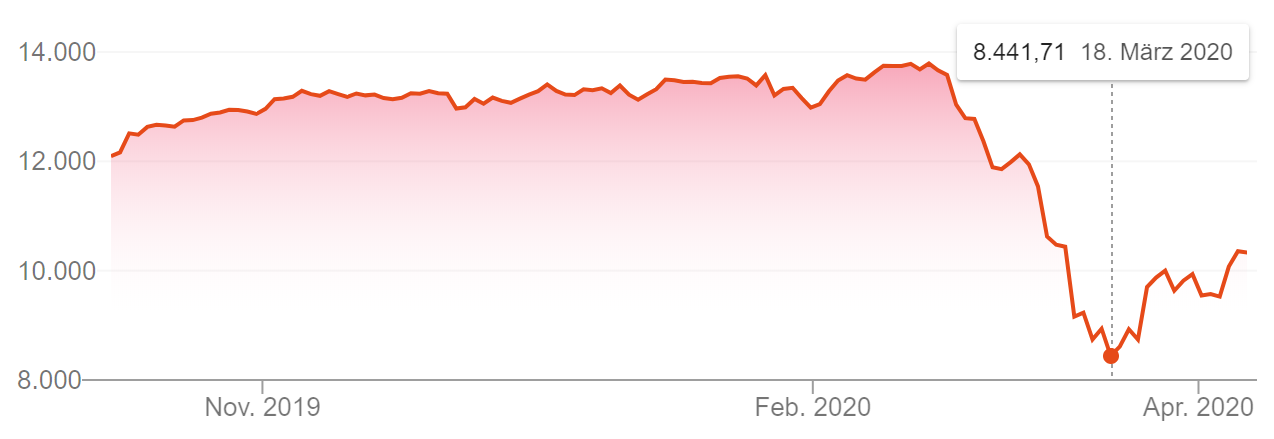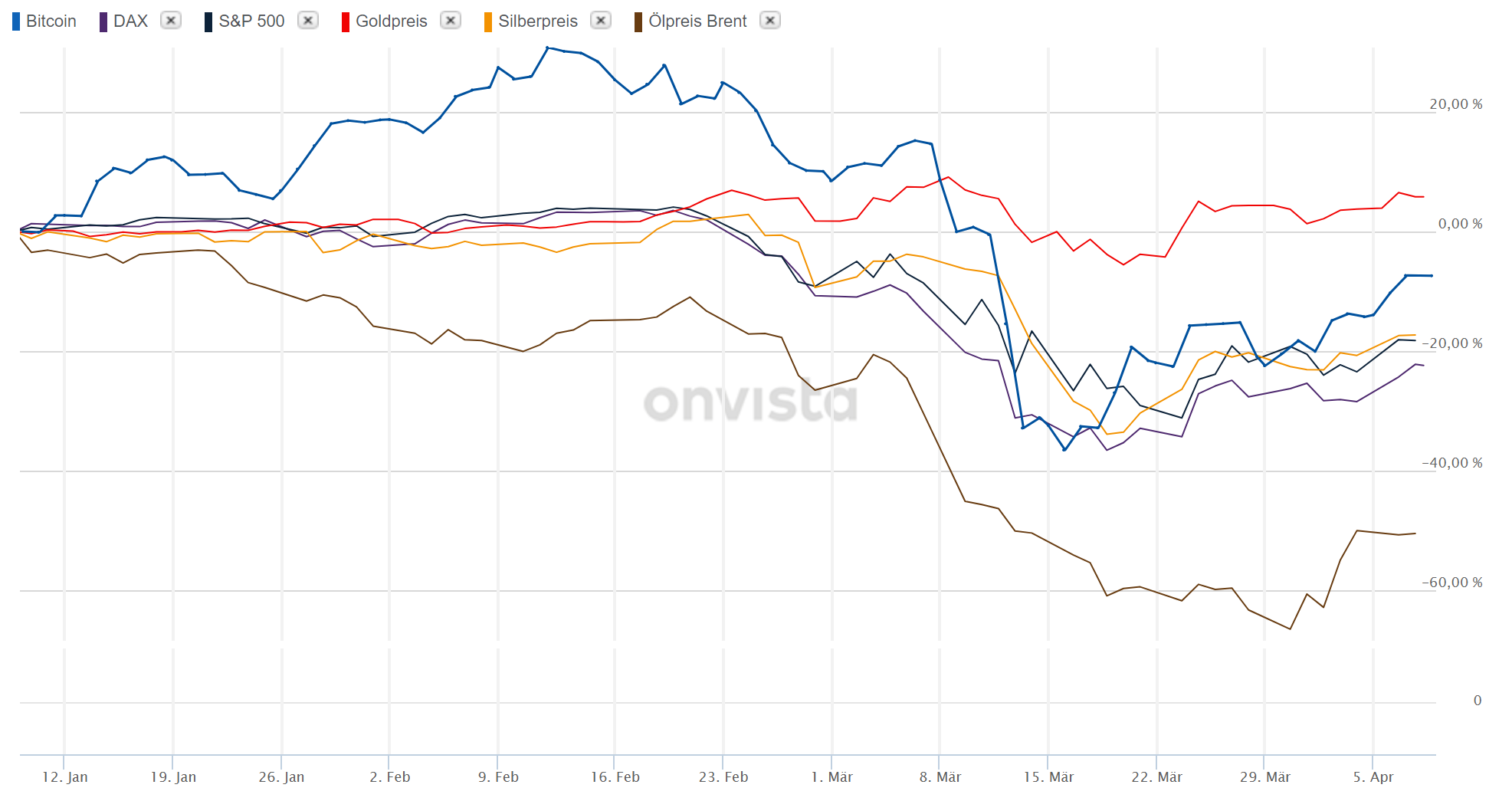How the Corona Crisis Has Shown Us That we Need Bitcoin, Ether & Co.
By Jonas Gross, Philipp Sandner, Victor von Wachter

Bitcoin was the first blockchain-based digital asset leading to a variety of other projects to follow. A key aspect of blockchain technology is its feature as an “electronic register” to organise legal rights and asset ownership. This core feature of blockchain can help the world encounter the risks that have materialized after the Coronavirus has spread: With digital assets in general, one could avoid physical banknotes that are suspected of spreading the virus.
Furthermore, digital assets can create new financial Instruments to address current inefficiencies while reducing transaction costs significantly. With Bitcoin, as the most prominent digital asset, there exists a scarce asset to be used as a store of value and hedge against inflation. This provides the ability to move wealth through decades. Finally, blockchain-based identity management and digital identities could reduce the number of physical touchpoints. As an innovative idea, these identities could be combined with blockchain-based vouchers to supply goods and services directly to the society. Ultimately, digital identities could be combined with health certificates to identify people, which have been found to be immune to the Coronavirus.
Introduction
The Corona pandemic is shaking the global financial system. After the virus has reached Europe, the financial markets have been panicking: The German stock market index DAX lost more than 30% within two weeks (see Figure 1) — this has been one of the largest drops in history. The interest yield of government bonds increased tremendously — especially in the context of Italy, one of the countries most affected by the virus. These strong market reactions indicate that financial market participants were nervous and that a major recession is to be expected. Governments all around the world announced unprecedented economic stimulus programs — actually, all major economies have announced support programs in the size of billion or trillion US dollars. Besides, central banks introduced expansionary monetary policy measures by decreasing interest rates (e.g. Federal Reserve, Bank of England) or by launching new asset purchase programs (e.g. Federal Reserve, European Central Bank). The pandemic reveals current weaknesses and inefficiencies of the global financial system, and it demonstrates that crypto assets, like Bitcoin and Ether, will be an essential part of the future financial system due to its inherent features.
Figure 1: German stock market index DAX during the Corona-caused crash[1]

Digitization of payments
Blockchain-based assets are fully digital, i.e. providing a digital value claim, payment and settlement, replacing drawbacks of a physical infrastructure.
Closed banks and limits for cash withdrawals
As a consequence of the Coronavirus, various banks have closed their subsidiaries, e.g. in Germany and the USA. Especially rural areas with only one bank nearby were hit hard. Consequently, the elderly, who were supposed to stay at home not to risk their health, lost their access to the financial system. But even more: In some countries, limits for cash withdrawals have been introduced so that some clients could not withdraw funds in their intended amount.
Bitcoin, in contrast, is available any time, and there are no withdrawal limits. Bitcoin can be obtained and transferred independently of the location — also in rural areas — at any time and even on weekends or holidays. Clients only need a smartphone, internet and a wallet. Despite all the stress apparent in the financial system, Bitcoin is processing transactions in a regular manner and is reliably producing one block every 10–11 minutes. Like a Swiss clock. Therefore, the Bitcoin system has again proven to be very resilient — even in situations of financial market panic. Note that due to the decrease in the Bitcoin price, the hash rate dropped accordingly. However, this is a normal behaviour of the system, not a bug.
Of course, this is not only the case for Bitcoin but for all major crypto assets. It would also be the case for enterprise blockchain networks that are expected to run in the future. Payments, in general, have gotten digital to some degree and will now go much more digital in a short time. Consequently, the need for banks’ opening hours and banknotes will be reduced.
Corona contagion via banknotes
Researchers have found out that germs of viruses, e.g. of the coronavirus, persist on banknotes. The World Health Organization (WHO) has admitted that germs might stay on banknotes for quite some time. According to a study in the Journal of Hospital Infection, some strains of the coronavirus can stay on banknotes for up to five days.[2] In Singapore, the Monetary Authority has recommended the public to use contactless payment methods as often as possible.[3] The Chinese central bank undertook concrete measures and has been disinfecting banknotes to remove the germs of the virus.
Certainly, using digital forms of money, as crypto assets, would lower the risk of virus contagion. Comparable to the well-known tech giants Apple Pay and Google Pay, a variety of mobile-first digital wallets already exists. With those apps, a smartphone can be used to conveniently transfer crypto assets from A to B without the need of physical cash and therefore without risk of virus infection through touching dirty banknotes or even dirtier coins.

Tokenization of assets
Digital assets can reduce fees and transaction costs to a minimum while offering new, innovative financial instruments that can be designed to be stable even in times of crisis.
Gold and silver: Tremendous fees and limited availability
In times of crisis, the demand for precious metals, such as gold and silver coins or bars, increases. Customers see precious metals as solid stores of value and therefore, as a tool to hedge price fluctuations in times of crisis. Also this time, in March, demand for precious metals increased so heavily that most (online) gold shops, e.g., Degussa in Germany, were sold out very quickly. Further, local subsidiaries of shops selling precious metals had to be closed due to high risks of infection. As a reaction to the limited supply and the increased demand of gold, competitors, such as German banks, increased the fees for precious metal purchases so that the spread between the market price of gold and the offered price for a gold purchase — in our personal case — equalled more than 10 per cent. The situation with silver was even more severe. The spread between the market price and the offered purchase price was more than 100 (!) per cent.
This situation has revealed that the markets for precious metals are currently not sufficiently efficient and competitive with a few actors having immense market power. The market power of these sellers was even amplified by the fact that competitors had to close their subsidiaries. Hence, these players could charge an even higher amount of fees and clients would still buy precious metals.
Inflexible gold products
The use of blockchain technology could increase competition in this field and provide tremendous efficiency gains. Under the umbrella term of “tokenization” physical commodities, precious metals and other assets can be brought to blockchain systems. Broadly speaking, a legal claim on a physical asset (in this context, gold or silver) is wrapped in a blockchain-based digital token.
Digital tokens can, therefore, act as containers of a physical gold bar; the blockchain is consequently the distribution network. The transaction fees of tokenized gold could be reduced significantly compared to the traditional distribution as intermediaries become reluctant, and the settlement of tokenized gold takes place nearly immediately at low costs. Tokenized gold further becomes available 24/7 as crypto assets can be traded anytime. If one intends to sell gold, one could simply swap it with one transaction, for example, swap digital gold for digital silver. Lastly, using blockchain improves flexibility for customers as digital gold can be traded in small fractions. Whereas one gold bar could be too expensive and gold is not available on a high variety of different sizes, tokenized gold could be traded on every unit imaginable — therefore satisfying any customer’s need.
Today, it is already possible to buy tokenized gold. Among the leading projects, PAX Gold is a crypto asset backed by one ounce of a physical gold bar. The legal claim wrapped in this crypto asset is “printed” on the blockchain. However, note that currently issuers of tokenized gold are not regulated. Hence, clients have to trust the issuer that the backed amount of gold will actually be paid out.
Predictable money supply
The money supply of Bitcoin, the dominating crypto asset, is mathematically determined and therefore predictable providing a high degree of stability.
Tremendous public interventions
In the current crisis, the calls for centralized expansionary interventions appeared very early from economic leaders and politicians. Since the financial crisis in 2008/2009, governments and central banks have increased their power and added tremendous central interventions as policy instruments in times of crisis. Only four weeks after the virus has fully “arrived” in the west, one of the largest economies in the world, the USA and the European Union, introduced significant expansionary measures. In fast and consequent steps, the leaders of both economies announced massive economic support programs accounting for more than 2.15 trillion USD (US) and 1.2 trillion USD (EU).[4] Further, also, the central banks introduced large scale stimulus programs. The sheer size of these stimulus programs is significant, raising the fear of increased money supply. Admittedly, if the circulating velocity of money within a society decreases due to the shock, higher money supply is needed to keep prices stable. Still, for believers into Bitcoin, the significant centralized actions are the wind in the sails. Bitcoin is the digital form of a very strict economic school, where there is no centralized power over monetary decisions and the monetary policy is solely made through the community (in some points comparable to the “Austrian School”). In the case of Bitcoin, the monetary policy is solely determined by math implemented in the core code and will presumably never be subject to change. The policy is predetermined until 2140, which offers the benefit of unprecedented predictability.
Crash of all asset classes including Bitcoin
The issuance of new Bitcoin, currently at a yearly growth rate of 3.8%, will be even cut to half this summer to 1.9%. As this rate halves every four years, this creates a digitally scarce asset and in theory, a very well protection against inflation (and hyperinflation) to preserve wealth through decades. However, in this crisis, this theory of a digital safe haven asset has been tested, as the price of Bitcoin fell with virtually all other assets like gold, stocks and bonds. The overall size of the crypto market dropped from a market size of 224 billion USD on Thursday 03/12 to 126 billion USD on Friday 03/13. [5] As the predominant crypto asset, also Bitcoin lost a remarkable share of its price within these two days. It fell from 7,911 USD to 4,474 USD hitting the floor of 2020 (see Figure 2).
Figure 2: Return of various asset classes in times of the Corona crisis [6]

Mostly, this sharp drop can be explained by a global “flight to safety”. In the soak of worldwide tumults, the price of (almost) every asset class declined, as panicking investors liquidated their assets to obtain “secure” fiat currencies, such as Euro and US dollar. The drop in crypto markets was further amplified by a relatively high percentage of leveraged positions. A massive volume of margin calls on trading platforms such as BitMex and Deribit forced liquidations, pushing down the prices even further. Besides these short term effects, we argue that Bitcoin indeed can be seen as a store of value. When “black swan” events occur — in a frequency of only a few times in a hundred years — then short term price declines induced by panic sell-offs are reasonable and can easily be explained. As indicated by the tremendous centralised interventions by governments and central banks, current systems are also not sufficiently robust against “black swan” events.
It is important to highlight that the fundamentals of Bitcoin did not change. Crypto assets — and in particular Bitcoin — are digital, decentralised assets with a very strict monetary policy, which implies scarcity. These fundamentals are still very promising. Bitcoin was invented during the last financial crisis in 2008 with the idea of creating an alternative monetary system in contrast to the traditional financial system. Currently, Bitcoin is still considered globally a risky asset, which is sold in a crisis in favour of fiat currencies. Bitcoin and other digital assets now have the huge opportunity to be further tested to determine their place in the monetary system of the future.
Innovative management of identities
Although not yet in place, various other promising use cases will be driven by blockchain technology and provide support in times of (the Corona) crisis: blockchain-based identity management, health certificates and vouchers.
Identity management
Identity management based on blockchain could help to mitigate the Corona crisis. If identities of people are supported by a blockchain-based system, it would not be necessary to have a physical ID card or a health insurance card anymore. Social distancing would be eased if one could sign contracts with one’s digital identity, and would not have to physically visit a doctor only to hand in a physical health insurance card.
Health certificates
Once the implemented restrictions will be lifted, it will be key to know which people already have been infected and whether — therefore — a person is consequently immune against the virus. Immunity against the Coronavirus is key. It would, therefore, be reasonable to issue health certificates to those people that are immune. These people could move in our society without any danger to others. Health certificates would have to be bound to people’s identities. Even elderly people could participate in public life — but only if their cell phone identifies them and if they have a valid immunity certificate.
Vouchers
In various countries, the economic activities will be at risk and the economy slows down. This can have adverse effects on the supply of goods, in particular the supply of food. To allow a fair distribution of potentially scarce goods, a voucher system could be introduced. Vouchers would be issued to people such that they can consume goods and services up to a previously specified limit. This can also include travelling and other social activities which need to be restricted — be it because it is too risky or be it that supply needs to be limited. If such vouchers are bound to people’s identities, it would also be possible to prevent a secondary market where people would trade their vouchers with others. Interestingly, the German government expressed appreciation for such an idea. [7]
Conclusion
We argue that the current crisis is an opportunity for crypto assets and blockchain, having a crucial impact on the development of the blockchain ecosystem for the next few years. The challenge is now to draw the correct conclusions and to build systems, tools and applications which provide real value out of crypto assets and blockchain. Crypto assets are digital by nature, thus do not have “physical” limitations. Neither do they need teller machines for cash withdrawals nor physical settlements and storage (e.g. gold, silver). Further, the monetary policy of crypto assets is more transparent and restricted. Bitcoin’s core design is to be a scarce digital asset. In times where governmental monetary policies are unforeseeable, crypto assets provide a real alternative. Still a niche, blockchain surrounding ecosystem and investment theories (“Safe-haven asset”) are now being tested, which is positive as it improves the general understanding of this asset class. Further, blockchain could also be used to mitigate the impact of the Coronavirus by providing blockchain health certificates and vouchers linked to one’s identity.
Naturally, we see this also as an opportunity to even dive deeper into the fundamentals of crypto. As the world is operating in home-office mode this daily dose of crypto and blockchain can be applied easily by everyone! [8] Companies could use the lockdown to foster education — the blockchain ecosystem is loaded with digital learning materials. [9]
But with all the news around Corona, crypto assets and blockchain, first and foremost, we wish every reader to stay safe and healthy!
Remarks
If you like this article, we would be happy if you forward it to your colleagues or share it on social networks. More information about the Frankfurt School Blockchain Center on the Internet, on Twitter, or on Facebook.
Jonas Gross is a project manager and research assistant at the Frankfurt School Blockchain Center (FSBC). His fields of interest are primarily cryptocurrencies. Besides, in the context of his Ph.D., he analyzes the impact of blockchain technology on the monetary policy of worldwide central banks. He mainly studies innovations as central bank digital currencies (CBDC) and other cryptocurrency projects as “Libra”. You can contact him via mail ([email protected]), LinkedIn (https://www.linkedin.com/in/jonasgross94/), Xing (https://www.xing.com/profile/Jonas_Gross4) or follow him on (Twitter Jonas__Gross).
Prof. Dr. Philipp Sandner is head of the Frankfurt School Blockchain Center (FSBC) at the Frankfurt School of Finance & Management. In 2018, he was ranked as one of the “Top 30” economists by the Frankfurter Allgemeine Zeitung (FAZ), a major newspaper in Germany. Further, he belongs to the “Top 40 under 40” — a ranking by the German business magazine Capital. The expertise of Prof. Sandner, in particular, includes blockchain technology, crypto assets, distributed ledger technology (DLT), Euro-on-Ledger, initial coin offerings (ICOs), security tokens (STOs), digital transformation and entrepreneurship. You can contact him via mail ([email protected]) via LinkedIn (https://www.linkedin.com/in/philippsandner/) or follow him on Twitter (@philippsandner).
Victor von Wachter is a product manager and blockchain engineer at the Swiss-based Smart Valor Digital Asset Exchange. His fields of interest are primarily blockchain protocols, Staking, STOs, and DeFi at the interface between business, technology and data. His research at the Technical University Munich contributed to the development of the ERC1400 and ERC1410 Security Token Standard. You can reach him via email ([email protected]) or LinkedIn (https://www.linkedin.com/in/victor-von-wachter).
Endnotes
[1] https://markets.ft.com/data/indices/tearsheet/summary?s=DAXX:GER
[2] G. Kampf, D. Todt, S. Pfaender, E. Steinmann, “Persistence of coronaviruses on inanimate surfaces and their inactivation with biocidal agents”, Journal of Hospital Infection, Vol. 104, Issue 3, p. 246–251.
[3] https://www.centralbanking.com/central-banks/currency/7509046/will-cash-survive-covid-19.
[4] https://www.ft.com/content/0f289d20-6e97-11ea-89df-41bea055720b.
[5] https://www.coingecko.com/en/global_charts.
[7] https://www.handelsblatt.com/technik/it-internet/euro-token-digitalstaatsministerin-baer-macht-sich-fuer-digitale-gutscheine-auf-blockchain-basis-stark/25696622.html?ticket=ST-521579-lb57YymKwy5R3T6g9GB4-ap3.
[8] https://medium.com/@philippsandner/education-in-blockchain-how-to-acquire-the-necessary-knowledge-with-a-workload-of-10-working-days-9091dc8a3c53.
[9] https://a16z.com/2018/02/10/crypto-readings-resources/.
Photo by Alec Favale on Unsplash
More Articles:
Sharpen your focus to provide real value
You Might also Like















